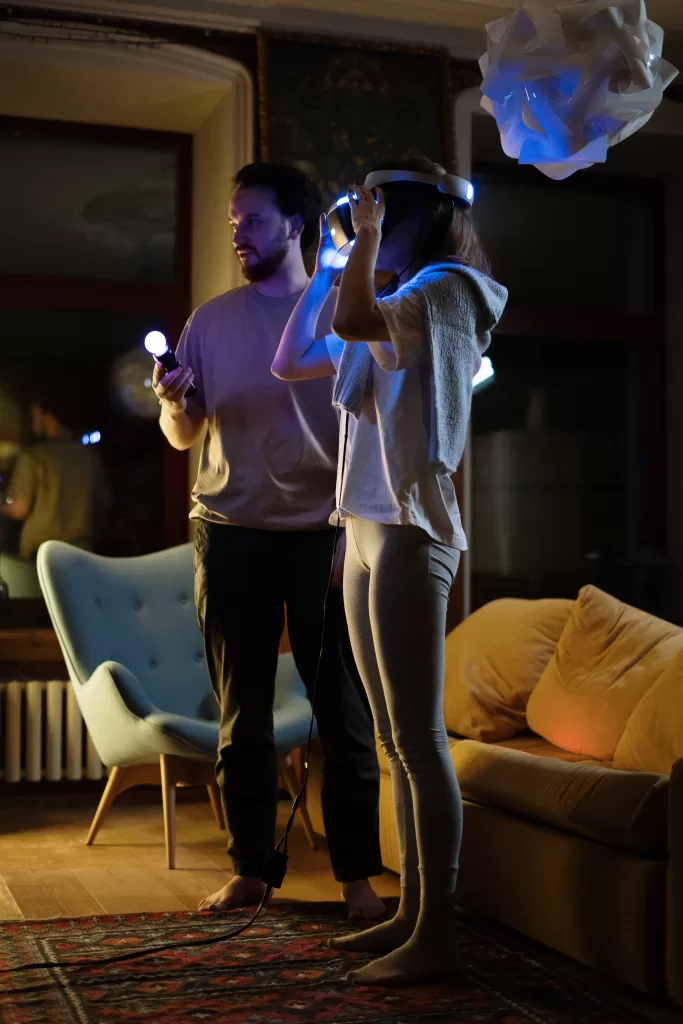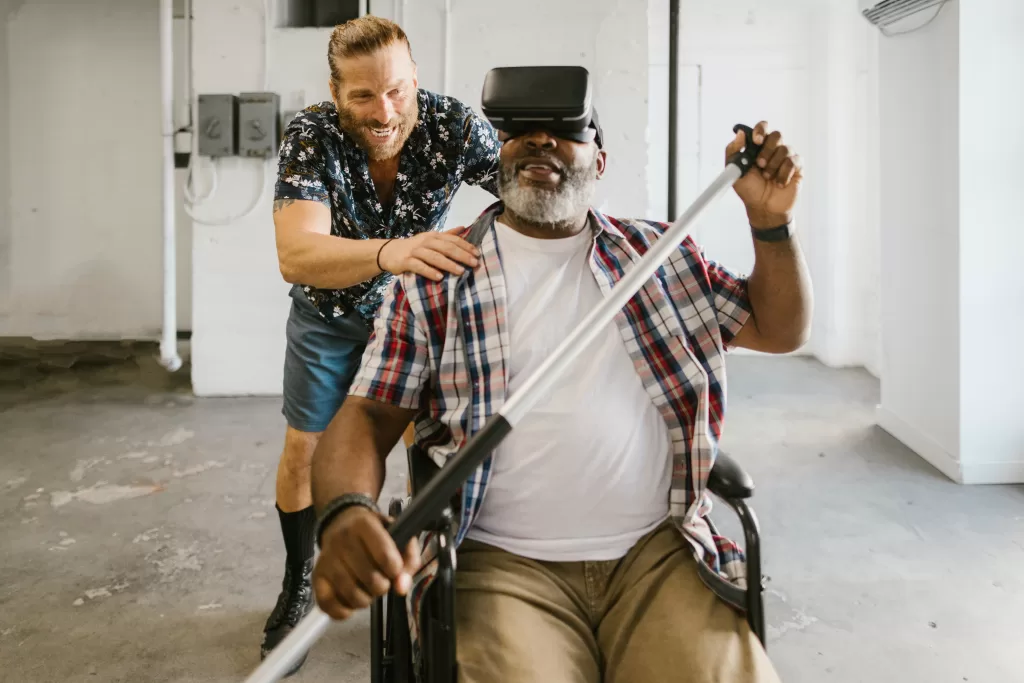Beyond Boundaries: Unveiling the Limitless World of Virtual Reality
Step into a world where imagination meets reality—welcome to the captivating realm of virtual reality (VR). Before we dive into the exciting career prospects that await, let’s take a moment to understand what VR truly entails. VR is a groundbreaking technology that transports users into simulated environments, tricking their senses and creating immersive experiences that blur the line between what’s real and what’s virtual. From strapping on a VR headset and exploring fantastical game worlds to using VR as a powerful tool in education, healthcare, and various industries, the potential of this technology is awe-inspiring. So, join us on this exhilarating journey as we unlock the secrets of VR and uncover the incredible career paths that lie ahead in this ever-evolving landscape of boundless imagination.
Virtual reality (VR) is a technology that creates an immersive, computer-generated environment that simulates a user’s physical presence in a virtual or imaginary world. Users can interact with this environment as if they were actually there, using specialized hardware such as a VR headset or gloves equipped with sensors.
The concept of VR is to create a completely artificial environment that users can interact with in a way that feels natural and real. VR typically uses a combination of 3D graphics, audio, and other sensory stimuli to create this illusion of presence.

Photo by cottonbro studio
One of the key differences between VR and other related technologies like augmented reality (AR) and mixed reality (MR) is the level of immersion. While AR and MR both add virtual elements to the real world, VR creates a completely virtual world that the user is fully immersed in.
For example, imagine playing a VR game where you are transported to a virtual world where you can interact with other players, objects, and environments as if they were real. You might be able to explore a castle, fight monsters, or solve puzzles, all while feeling as if you are really there. This is different from AR, which might overlay virtual information onto the real world, such as displaying directions or information about nearby landmarks on a smartphone screen.
Another example of VR in action is in the medical field. Doctors and medical students can use VR to simulate surgical procedures or medical scenarios, allowing them to practice and refine their skills in a safe and controlled environment before working on real patients. This is different from MR, which might overlay virtual information onto a physical model of a patient, allowing doctors to see inside the body and plan surgical procedures more accurately.
Overall, virtual reality is an exciting and rapidly-evolving technology that has the potential to transform many different industries and applications.
Difference between VR, AR and MR
Virtual reality (VR) is like being transported to a completely different world that is created entirely by a computer. It’s like you are wearing a special headset that blocks out the real world and replaces it with a virtual one.
Augmented reality (AR) is like adding virtual things to the real world around you. For example, you might use your phone camera to see virtual furniture in your living room, or virtual creatures in your backyard.
Mixed reality (MR) is like a combination of VR and AR. It allows you to interact with virtual objects that appear to be part of the real world around you. For example, you might wear a headset that shows virtual objects on a table in front of you, and you can touch and interact with them as if they were really there.
So, the main difference between VR, AR, and MR is the level of immersion and how much of the real world is replaced with virtual elements. VR is a completely immersive virtual world, AR adds virtual elements to the real world, and MR allows you to interact with virtual elements that appear to be part of the real world.
Brief history of Virtual Reality
Virtual reality (VR) technology has a long and fascinating history that stretches back several decades. Here is a brief overview of the history of virtual reality, including its origins, major technological advancements, and notable milestones:
The concept of virtual reality was first introduced in the mid-20th century by science fiction writers like Ray Bradbury and Arthur C. Clarke. They imagined a future where people could immerse themselves in completely artificial worlds created by computers.
The first actual attempts at creating VR technology began in the 1960s, with the development of head-mounted displays (HMDs) that could project images onto screens in front of the user’s eyes.
In the 1970s, a number of pioneering computer scientists and engineers began experimenting with VR technology, including Ivan Sutherland, who created the first HMD with built-in sensors that could track the user’s movements.
Throughout the 1980s and 1990s, VR technology continued to develop rapidly, with the creation of more advanced HMDs, motion tracking systems, and computer graphics software.
One of the major milestones in the history of VR was the creation of the Virtual Boy, a gaming console released by Nintendo in 1995. Although it was not a commercial success, it was one of the first attempts to bring VR technology to the masses.
In the 2000s, VR technology began to be used for a variety of applications beyond gaming, including military training, medical simulations, and scientific research.
The most recent wave of VR technology began in the mid-2010s, with the introduction of affordable, consumer-grade VR headsets like the Oculus Rift and HTC Vive. These devices made VR technology more accessible to the general public and sparked a new wave of interest in the technology.
Today, VR technology continues to advance rapidly, with new hardware, software, and applications being developed all the time. It is used in fields as diverse as entertainment, education, healthcare, and business, and is likely to play an increasingly important role in our lives in the coming years.
VR: Gaming and Entertainment
Virtual reality (VR) technology has revolutionized the gaming and entertainment industry, allowing players to fully immerse themselves in digital worlds and experiences. Here are a few examples of popular VR games and experiences that showcase the potential of the technology:
Beat Saber: This is a rhythm-based VR game where players use virtual lightsabers to slice through blocks that come flying at them to the beat of music. The game has become incredibly popular due to its simple yet addictive gameplay and the way it makes players feel like they are actually wielding lightsabers.
Job Simulator: This is a comedic VR game that takes place in a future where robots have taken over all the jobs. Players take on various silly jobs like a cook, a store clerk, and an office worker, completing various tasks in each role. The game showcases the potential of VR for immersive, interactive storytelling and comedy.
VR rollercoasters: Many theme parks and amusement parks have started to incorporate VR technology into their rollercoaster rides, allowing riders to feel like they are soaring through completely different environments like space, underwater or a fantasy world. Riders wear a VR headset while riding the coaster to provide a unique, immersive experience.
VR concerts: With the pandemic, many artists have turned to VR to perform virtual concerts for their fans. Virtual concerts use VR technology to create a completely digital environment where fans can watch and interact with the artist in real-time. This not only provides an immersive experience for the viewer, but also allows the artist to reach a wider audience.

Photo by RDNE Stock project
VR: Education and training
Here are some examples of how virtual reality (VR) is being used in education and training to enhance learning and skill development:
Medical training: VR is being used to train medical students and professionals on a variety of procedures and surgeries. For example, surgeons can practice complex procedures in a simulated environment before performing them on real patients. Medical students can also use VR to learn anatomy and gain a better understanding of the human body.
Historical simulations: VR is being used to create immersive simulations of historical events, allowing students to experience the past in a new way. For example, students can visit ancient Rome, explore the depths of the ocean to understand the Titanic’s sinking, or even experience the history of NASA’s missions to space.
Language learning: VR is being used to create immersive language learning environments where students can practice their language skills in a realistic setting. For example, students can practice conversing with virtual native speakers or immerse themselves in a foreign city and practice their language skills in a realistic environment.
Soft skill training: VR is being used to help employees develop their soft skills, such as public speaking, leadership, and conflict resolution. For example, employees can practice delivering a presentation to a virtual audience or navigating difficult conversations in a safe, simulated environment.
Autism therapy: VR is being used as a tool to help children with autism spectrum disorders develop social skills. For example, children can practice social interactions in a simulated environment with virtual characters that mimic real-life situations.
VR: Healthcare
Virtual reality (VR) technology is being used in various ways to improve patient outcomes in healthcare. Here are some examples of how VR is being used in healthcare:
Pain management: VR is being used to help manage pain in patients with chronic pain conditions. For example, patients can wear a VR headset that transports them to a calming environment while they undergo painful procedures like chemotherapy. Studies have shown that this can reduce patients’ perception of pain and anxiety during these procedures.
Anxiety and PTSD treatment: VR is being used to treat anxiety disorders and post-traumatic stress disorder (PTSD). Patients can undergo exposure therapy in a simulated environment that replicates the situations that trigger their anxiety or PTSD symptoms. For example, soldiers with PTSD can undergo therapy that simulates combat situations to help them cope with their symptoms.
Rehabilitation: VR is being used in physical and occupational therapy to aid in rehabilitation after an injury or illness. Patients can undergo therapy that simulates real-life activities and environments to help them regain strength and mobility. For example, stroke patients can undergo therapy that simulates activities of daily living like cooking or dressing themselves.
Surgical planning and training: VR is being used to aid in surgical planning and training. Surgeons can use VR to visualize and practice complex procedures before performing them on real patients. This can help reduce the risk of complications and improve patient outcomes.
Medical education: VR is being used to enhance medical education by providing immersive experiences for students to learn about anatomy, physiology, and disease states. Medical students can practice procedures and surgeries in a simulated environment, allowing them to gain experience before performing them on real patients.
VR: Military and Defense
Virtual reality (VR) technology is being used by the military and defense industries for various purposes, including training, situational awareness, and more. Here are some examples of how VR is being used in military and defense:
Training simulations: VR is being used to train soldiers in a variety of scenarios and situations. For example, soldiers can undergo simulations that replicate combat situations, practice convoy operations, or train for hazardous environments like chemical spills or nuclear disasters.
Flight simulation: VR is being used to train pilots and aircrew in flight simulators that replicate real-world scenarios. This can help improve their skills and reduce the risk of accidents during actual flight operations.
Situational awareness: VR is being used to improve situational awareness on the battlefield. Soldiers can wear VR headsets that provide them with a 360-degree view of their surroundings, including real-time data and intelligence. This can help them make more informed decisions and react more quickly to changing situations.
Maintenance and repair: VR is being used to train soldiers and technicians in the maintenance and repair of equipment and vehicles. They can practice repairing complex systems and components in a simulated environment before working on them in the field.
Cybersecurity: VR is being used to train cybersecurity professionals in identifying and mitigating cyber threats. They can practice defending against virtual attacks in a simulated environment before facing them in the real world.
VR: Businesses and Industries
Virtual reality (VR) technology is being used by businesses and industries for various purposes, including product design, testing, and training. Here are some examples of how VR is being used in business and industry:
Product design and development: VR is being used to design and develop new products in a virtual environment. Designers and engineers can visualize and test product prototypes in a simulated environment, making it easier and more cost-effective to identify and correct design flaws before building physical prototypes.
Manufacturing and assembly: VR is being used to train employees in manufacturing and assembly operations. Workers can practice assembling products or operating machinery in a simulated environment, improving their skills and reducing the risk of errors or accidents on the production line.
Sales and marketing: VR is being used to enhance sales and marketing efforts. Companies can create immersive experiences that allow customers to visualize and interact with products in a virtual environment. For example, a car manufacturer could create a VR experience that lets customers “test drive” a car before buying it.
Real estate: VR is being used in the real estate industry to create virtual property tours for potential buyers. Customers can view and explore properties in a simulated environment, making it easier to narrow down their choices before visiting them in person.
Training and education: VR is being used to train employees in a variety of industries, including healthcare, aviation, and hospitality. Employees can practice skills and procedures in a simulated environment, making it easier and more cost-effective to train large numbers of employees.
Future of VR
The future of virtual reality (VR) is exciting, with many new applications and technological advancements on the horizon. Here are some of the possibilities:
Healthcare: VR has the potential to revolutionize healthcare by providing more immersive and effective treatments for a variety of conditions. As the technology continues to improve, we may see VR being used to treat more complex conditions and illnesses.
Education: VR has already shown promise as a tool for teaching and training, but as the technology becomes more widely available, we may see it being used in new and innovative ways. For example, VR could be used to create more engaging and interactive learning environments, or to help students with special needs.
Collaboration and communication: VR could be used to facilitate remote collaboration and communication, allowing people in different locations to work together in a shared virtual environment. This could be particularly useful for businesses with global teams, or for industries that require frequent collaboration, such as architecture and design.
Entertainment: As VR technology improves, we may see even more immersive and realistic gaming and entertainment experiences. This could include more interactive and social experiences, as well as more realistic simulations of real-world environments.
Augmented reality: While VR creates a fully immersive virtual environment, augmented reality (AR) overlays virtual elements onto the real world. As AR technology improves, we may see new applications in areas such as education, entertainment, and advertising.
Advancements in hardware: As VR technology becomes more advanced, we may see improvements in the hardware used to create and experience VR. This could include more comfortable and lightweight headsets, more realistic haptic feedback, and improved motion tracking.
Overall, the future of VR looks bright, with many new applications and technological advancements on the horizon. As the technology continues to improve, we may see VR becoming even more transformative, impacting a wide range of industries and changing the way we live, work, and play.
Making a Career in the Virtual Reality (VR) Field
With the rapid advancement and increasing popularity of virtual reality (VR) technology, pursuing a career in this field can be an exciting and rewarding choice. Here are some steps you can take to make a career in the VR industry:
Gain a strong foundation: Start by acquiring a solid foundation in the relevant skills and knowledge areas. This may include studying computer science, computer graphics, game development, 3D modeling, user experience design, or animation. Take courses, pursue certifications, and participate in workshops to develop your expertise.
Specialize in VR technology: Focus on developing specific skills related to VR technology. This could involve learning VR development platforms such as Unity or Unreal Engine, understanding VR hardware and software, and staying updated with the latest industry trends and advancements.
Build a portfolio: Create a portfolio that showcases your VR projects and demonstrates your skills and creativity. Include examples of VR applications, games, or experiences you have developed. This will serve as evidence of your abilities and help you stand out to potential employers or clients.
Gain practical experience: Seek opportunities to gain practical experience in the VR field. Consider internships, freelance projects, or volunteering for VR-related initiatives. This hands-on experience will not only enhance your skills but also provide valuable networking opportunities.
Join VR communities and events: Engage with the VR community by participating in forums, attending industry conferences, and joining VR-focused groups or organizations. This will allow you to network with professionals, stay informed about the latest developments, and discover potential job opportunities.
Seek employment in VR-related industries: Look for job openings in industries that utilize VR technology, such as gaming, entertainment, healthcare, education, architecture, engineering, or marketing. Positions could include VR developer, UX designer, 3D artist, VR content creator, or VR project manager.
Continuous learning and adaptation: The VR field is evolving rapidly, so it’s crucial to stay updated with emerging technologies, tools, and techniques. Keep learning and adapting to new developments through online resources, tutorials, workshops, and industry publications.
Consider entrepreneurship: If you have an entrepreneurial spirit, you can start your own VR-related business. This could involve developing VR applications or experiences, offering VR consulting services, or creating VR content for various industries.
Remember, building a successful career in the VR field requires passion, perseverance, and continuous learning. Stay curious, be open to new opportunities, and embrace the transformative potential of VR technology. With dedication and the right skill set, you can carve out a rewarding career in this dynamic and rapidly expanding industry.








